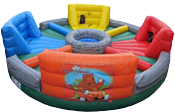Inflatable bounce houses are becoming more and more popular. But, from time to time, there are accidents. Probably as a newer you are hard in this industry.
What can be done to avoid injuries to children and play happily? This article starts with the possible risk factors and effective avoidance methods, to teach you how to safely operate the bounce house with slide.
Dangerous factors
I agree with the experts the main factors that cause injuries to children are these.
- Falling while playing on the inflatable bouncers.
- Children are too different in size and age and bump with each other.
- Easy to slip and fall on rainy days.
- The ground anchor is not fixed firmly, easy to move.
- Used in strong windy weather, the jump house is blown away by the wind.
- No adult supervision, effective diversion, overcrowding causes bruises.
- Poor quality of inflatable jump house, tearing causing injury.
Risk avoidance
Safe fixed inflatable jumpers
- Away from fences, tree branches, power lines, etc.
- Fixed on a flat, clutter-free lawn.
- Commercial grade inflatable houses should always be secured with 30-40 inch ground anchors.
- Wind speeds of 20 to 25 miles per hour or higher keep children away from the bounce house and end operations.
- Get insurance, regular moon bounce inspections, staff safety training. etc. to make sure everything is safe.
- Have a first aid kit available in case of emergency. Discuss emergency plans with other parents. In case of any injury, take off immediately to avoid secondary injuries.
Proper supervision
- Always have 1-2 adults supervising when playing.
- Over 6 years old play, parents or staff should always be present to supervise the Children’s play.
- Children under 6 years old need close attention, in case the child loses balance and falls.
- For toddlers, parents need to hold hands and guide them to play.
Follow safety rules
For the child to play safely and happily. Before entering the moonwalks, be sure to tell kids all the rules, as well as the possible harm against the rules.
- Do not let children of different sizes and ages play together. To avoid collision injuries.
- Do not let too many children play together. Control the number and weight to avoid crowding injuries. Have enough space to play safe and well.
- Do not let another child slide before one child runs off the slide. Avoid being hit.
- Make sure to sit firmly, slide down with your feet, and get up and run away immediately after landing.
- Do not wear shoes, glasses or jewelry and other accessories. to avoid injuries.
- Do not carry sharp objects such as pens, keys, etc. to avoid stabbing.
- Wear comfortable socks to prevent slips and falls.
- Do not make flips or jump in the air inside to prevent hurt.
- Do not fool around, wrestle or use violence inside, and should be stopped as soon as finding it.
- Do not play at the entrance and exit to avoid being hit.
- Do not eat inside to avoid injury or suffocation.
Check before operation
Remember to have a safety checklist before children enter the inflatable unit, this will also help ensure their safety.
- Is there adult supervision?
- Is the metal anchor secured? Are they 5 feet apart? Has the sandbag been used?
- How many kids are using it?
- Were there any sharp objects on the children’s clothing? Are they wearing shoes?
- Is it windy?
Buy a safe commercial grade inflatable bounce house
Dumbosports’ commercial inflatables are good quality and have a 3-year warranty. They can meet your requirements.
Conclusion
With a commercial-grade bounce house and reasonable risk aversion, you will surely be able to master the secret of safe business soon.
If you need to know more, please drop me a line.


2 回复
My son is turning eight this spring, and I would like to rent a bounce house for his birthday party. It was really helpful when you explained that it is important to make sure that the bounce house is fixed on a flat surface. I would think that it would also be a good idea to avoid setting it up on a surface that has a lot of rocks.
I’m glad it was helpful.
And it is a great idea to avoid rock surfaces. Thank you, Henry.